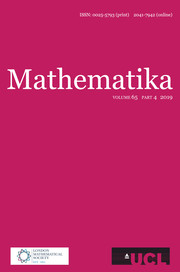Crossref Citations
This article has been cited by the following publications. This list is generated based on data provided by
Crossref.
Ewald, Günter
1980.
Geometry and Differential Geometry.
Vol. 792,
Issue. ,
p.
54.
Altshuler, Amos
and
Shemer, Ido
1984.
Construction theorems for polytopes.
Israel Journal of Mathematics,
Vol. 47,
Issue. 2-3,
p.
99.
von Pachner, U.
1987.
Konstruktionsmethoden und das kombinatorische Homöomorphieproblem für Triangulationen kompakter semilinearer Mannigfaltigkeiten.
Abhandlungen aus dem Mathematischen Seminar der Universität Hamburg,
Vol. 57,
Issue. 1,
p.
69.
Pachner, Udo
1987.
Ein Henkeltheorem FÜr Geschlossene Semilineare Mannigfaltigkeiten.
Results in Mathematics,
Vol. 12,
Issue. 3-4,
p.
385.
Makai, E.
and
Martini, H.
1989.
A lower bound on the number of sharp shadow-boundaries of convex polytopes.
Periodica Mathematica Hungarica,
Vol. 20,
Issue. 4,
p.
249.
Bezdek, K.
Bisztriczky, T.
and
Connelly, R.
1990.
On hyperplanes and polytopes.
Monatshefte f�r Mathematik,
Vol. 109,
Issue. 1,
p.
39.
Prabhu, N.
1995.
Facet-reducing cuts of a convex polytope.
Discrete & Computational Geometry,
Vol. 14,
Issue. 3,
p.
295.
Jockusch, William
and
Prabhu, Nagabhushana
1995.
Cutting a polytope.
Geometriae Dedicata,
Vol. 54,
Issue. 3,
p.
307.
Martini, Horst
1996.
Shadow-boundaries of convex bodies.
Discrete Mathematics,
Vol. 155,
Issue. 1-3,
p.
161.
Strutu, Mircea-Ionel
Stoican, Florin
Prodan, Ionela
Popescu, Dan
and
Olaru, Sorin
2013.
A characterization of the relative positioning of mobile agents for full sensorial coverage in an augmented space with obstacles.
p.
936.
Stoican, Florin
Prodan, Ionela
Strutu, Mircea-Ionel
and
Popescu, Dan
2014.
Geometrical interpretation on the coverage problems for a mobile agent.
p.
785.
Myroshnychenko, Sergii
2019.
On Recognizing Shapes of Polytopes from Their Shadows.
Discrete & Computational Geometry,
Vol. 62,
Issue. 4,
p.
856.
 of S, which we call a (sharp) shadow-boundary ofP.
of S, which we call a (sharp) shadow-boundary ofP.  is combinatorially isomorphic to the boundary complex of a poly tope which is a central projection of P from the point p on a hyperplane.
is combinatorially isomorphic to the boundary complex of a poly tope which is a central projection of P from the point p on a hyperplane.
